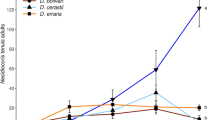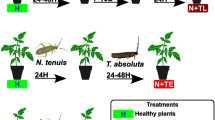Abstract
The first record of the omnivorous predator Dicyphus maroccanus Wagner (Hemiptera: Miridae) inhabiting tomato crops in the Valencia region (East Coast of Spain) was in 2009. Since then, D. maroccanus has often been found preying on the eggs of Tuta absoluta (Meyrick) (Lepidoptera: Gelechiidae) in this area. To evaluate this predator’s potential as a biological control agent, its life-history traits in the presence and absence of prey [(eggs of Ephestia kuehniella Zeller (Lepidoptera: Pyralidae)] on tomato plants were studied under laboratory conditions. Immature stages that preyed on eggs of E. kuehniella developed successfully. However, no nymph completed development on the plant without the addition of E. kuehniella eggs. To reach adulthood, male and female D. maroccanus nymphs consumed 267 and 312 E. kuehniella eggs, respectively. The net reproductive rate (R0) was estimated to be 34.52 female eggs per female, the generation time (T) was 40.48 days, and the estimated intrinsic rate of increase (rm) was 0.0868 females per female per day at 25 °C. In a second experiment, the capacity to detect plants infested or not infested with T. absoluta was studied using a Y-tube olfactometer. Female D. maroccanus were strongly attracted to the odor of T. absoluta-infested plants. In a third experiment, the capacity of D. maroccanus to control T. absoluta on tomato plants was investigated under extended laboratory conditions. Dicyphus maroccanus significantly reduced the number of T. absoluta-infested leaves in over 90 % of cases relative to control conditions. These results suggest that D. maroccanus could play a significant role in T. absoluta management. The potential of this zoophytophagous predator as a biocontrol agent on tomato crops is discussed.




Similar content being viewed by others
References
Agustí N, de Vicente MC, Gabarra R (2000) Developing SCAR markers to study predation on Trialeurodes vaporariorum. Insect Mol Biol 9:263–268
Arnó J, Sorribas R, Prat M, Matas M, Pozo C, Rodríguez D, Garreta A, Gómez A, Gabarra R (2009) Tuta absoluta, a new pest in IPM tomatoes in the northeast of Spain. IOBC/WPRS Bull 49:203–208
Arnó J, Castane C, Riudavets J, Gabarra R (2010a) Risk of damage to tomato crops by the generalist zoophytophagous predator Nesidiocoris tenuis (Reuter) (Hemiptera: Miridae). Bull Entomol Res 100(1):105–115
Arnó J, Gabarra R, Liu TX, Simmons AM, Gerling D (2010b) Natural enemies of Bemisia tabaci: predators and parasitoids. In: Stansly PA, Naranjo SE (eds) Bemisia: bionomics and management of a global pest. Springer, Dordrecht, The Netherlands, pp 385–421
Belda JE, Giménez A, Calvo FJ (2011) Success and extension of biological control strategies for managing Tuta absoluta (Meyrick) (Lep.: Gelechiidae) populations in the Mediterranean area. In: EPPO/IOBC/NEPPO Joint International Symposium on management of Tuta absoluta (tomato borer). http://archives.eppo.org/MEETINGS/2011_conferences/tuta/brochure_tuta.pdf, Agadir, Morocco, November 16–18, 2011, p 35. Accessed 2 June 2014
Biondi A, Chailleux A, Lambion J, Han P, Zappalà L, Desneux N (2013) Indigenous natural enemies attacking Tuta absoluta (Lepidoptera: Gelechiidae) in Southern France. Egypt J Biol Pest Control 23:117–121
Birch LC (1948) The intrinsic rate of natural increase of an insect population. J Anim Ecol 17:15–26
Calvo FJ, Bolckmans K, Belda JE (2009a) Development of a biological control-based integrated pest management method for Bemisia tabaci for protected sweet pepper crops. Entomol Exp Appl 133:9–18
Calvo J, Blockmans K, Stansly PA, Urbaneja A (2009b) Predation by Nesidiocoris tenuis on Bemisia tabaci and injury to tomato. BioControl 54:237–246
Calvo FJ, Bolckmans K, Belda JE (2011) Control of Bemisia tabaci and Frankliniella occidentalis in cucumber by Amblyseius swirskii. BioControl 56:185–192
Calvo FJ, Lorente MJ, Stansly PA, Belda JE (2012a) Preplant release of Nesidiocoris tenuis and supplementary tactics for control of Tuta absoluta and Bemisa tabaci in greenhouse tomato. Entomol Exp Appl 143:111–119
Calvo FJ, Soriano J, Bolckmans K, Belda JE (2012b) A successful method for whitefly and Tuta absoluta control in tomato. Evaluation after two years of application in practice. IOBC/WPRS Bull 80:237–244
Cassis G, Schuh RT (2012) Systematics, biodiversity, biogeography, and host associations of the Miridae (Insecta: Hemiptera: Heteroptera: Cimicomorpha). Annu Rev Entomol 57:377–404
Castañé C, Arnó J, Gabarra R, Alomar O (2011) Plant damage to vegetable crops by zoophytophagous mirid predators. Biol Control 59:22–29
Chailleux A, Biondi A, Han P, Tabone E, Desneux N (2013) Suitability of the host-plant system Tuta absoluta-tomato for Trichogramma parasitoids and insights for biological control. J Econ Entomol 106:2310–2321
Cuthbertson AGS, Mathers JJ, Blackburn LF, Korycinska A, Luo W, Jacobson RJ, Northing P (2013) Population development of Tuta absoluta (Meyrick) (Lepidoptera: Gelechiidae) under simulated UK glasshouse conditions. Insects 4:185–197
Desneux N, Wajnberg E, Wyckhuys K, Burgio G, Arpaia S, Narvaez-Vasquez C, González-Cabrera J, Catalán-Ruescas D, Tabone E, Frandon J, Pizzol J, Poncet C, Cabello T, Urbaneja A (2010) Biological invasion of European tomato crops by Tuta absoluta: ecology, geographic expansion and prospects for biological control. J Pest Sci 83:197–215
Desneux N, Luna MG, Guillemaud T, Urbaneja A (2011) The invasive South American tomato pinworm, Tuta absoluta, continues to spread in Afro-Eurasia and beyond: the new threat to tomato world production. J Pest Sci 84:403–408
Figueiredo E, Prieto R, Mexia A, Rodrigues S, Costa CA, Godinho MC (2012) Mirid Bugs as biological control agents in protected tomato crops in the Oeste Region. 28th International horticultural congress on science and horticulture for people (Ihc2010): international symposium on greenhouse 2010 and soilless cultivation 927:253–259
Gabarra R, Alomar O, Castañé C, Goula M, Albajes R (2004) Movement of greenhouse whitefly and its predators between in- and outside of Mediterranean greenhouses. Agric Ecosyst Environ 102:341–348
Gillespie DR, Quiring DMJ (2005) Diapause induction under greenhouse conditions in two populations of Dicyphus hesperus (Hemiptera: Miridae). Biocontrol Sci Technol 15:571–583
González-Cabrera J, Mollá O, Montón H, Urbaneja A (2011) Efficacy of Bacillus thuringiensis (Berliner) in controlling the tomato borer, Tuta absoluta (Meyrick) (Lepidoptera: Gelechiidae). BioControl 56:71–80
Henderson CF, Tilton EW (1955) Tests with acaricides against the brown wheat mite. J Econ Entomol 48:157–161
Ingegno BL, Pansa MG, Tavella L (2009) Tomato colonization by predatory bugs (Heteroptera: Miridae) in agro-ecosystems of NW Italy. IOBC/WPRS Bull 49:287–291
Ingegno BL, Pansa MG, Tavella L (2011) Plant preference in the zoophytophagous generalist predator Macrolophus pygmaeus (Heteroptera: Miridae). Biol Control 58:174–181
Ingegno BL, Ferracini C, Gallinotti D, Alma A, Tavella L (2013) Evaluation of the effectiveness of Dicyphus errans (Wolff) as predator of Tuta absoluta (Meyrick). Biol Control 67:246–252
Mackauer M (1983) Quantitative assessment of Aphidius smithi (Hymenoptera: Aphidiidae): fecundity, intrinsic rate of increase, and functional response. Can Entomol 115:399–415
Maia ADHN, Luiz AJB, Campanhola C (2000) Statistical inference on associated fertility life table parameters using jackknife technique: computational aspects. J Econ Entomol 93:511–518
McGregor RR, Gillespie DR (2004) Olfactory responses of the omnivorous generalist predator Dicyphus hesperus to plant and prey odours. Entomol Exp Appl 112:201–205
Messelink GJ, Bloemhard CMJ, Kok L, Janssen A (2011) Generalist predatory bugs control aphids in sweet pepper. IOBC/WPRS Bull 68:115–118
Moayeri HRS, Ashouri A, Brodsgaard HF, Enkegaard A (2006) Odour-mediated responses of a predatory mirid bug and its prey, the two-spotted spider mite. Exp Appl Acarol 40:27–36
Moayeri HRS, Ashouri A, Brodsgaard HF, Enkegaard A (2007a) Males of the predatory mirid bug Macrolophus caliginosus exploit plant volatiles induced by conspecifics as a sexual synomone. Entomol Exp Appl 123:49–55
Moayeri HRS, Ashouri A, Poll L, Enkegaard A (2007b) Olfactory response of a predatory mirid to herbivore induced plant volatiles: multiple herbivory vs. single herbivory. J Appl Entomol 131:326–332
Mollá Ó, Montón H, Vanaclocha P, Beitia A, Urbaneja A (2009) Predation by the mirids Nesidiocoris tenuis and Macrolophus pygmaeus on the tomato borer Tuta absoluta. IOBC/WPRS Bull 49:209–214
Mollá O, Alonso M, Montón H, Beitia F, Verdú MJ, González-Cabrera J, Urbaneja A (2010) Control Biologico de Tuta absoluta. Catalogación de enemigos naturales y potencial de los míridos depredadores como agentes de control. Phytoma España 217:42–46
Mollá O, González-Cabrera J, Urbaneja A (2011) The combined use of Bacillus thuringiensis and Nesidiocoris tenuis against the tomato borer Tuta absoluta. BioControl 56:883–891
Mollá O, Biondi A, Alonso-Valiente M, Urbaneja A (2014) A comparative life history study of two mirid bugs preying on Tuta absoluta and Ephestia kuehniella eggs on tomato crops: implications for biological control. BioControl 59:175–183
Pérez-Hedo M, Urbaneja A (2014) Prospects for predatory mirid bugs as biocontrol agents of aphids in sweet peppers. J Pest Sci. doi:10.1007/s10340-014-0587-1
Sánchez JA, Lacasa A, Arnó J, Castañé C, Alomar O (2009) Life history parameters for Nesidiocoris tenuis (Reuter) (Het., Miridae) under different temperature regimes. J Appl Entomol 133:125–132
Stansly PA (2010) Bemisia: bionomics and management of a global pest. Springer, Dordrecht, The Netherlands
Urbaneja A, Montón H, Mollá O (2009) Suitability of the tomato borer Tuta absoluta as prey for Macrolophus pygmaeus and Nesidiocoris tenuis. J Appl Entomol 133(4):292–296
Urbaneja A, González-Cabrera J, Arnó J, Gabarra R (2012) Prospects for the biological control of Tuta absoluta in tomatoes of the Mediterranean basin. Pest Manag Sci 68:1215–1222
van Lenteren JC (2012) The state of commercial augmentative biological control: plenty of natural enemies, but a frustrating lack of uptake. BioControl 57:1–20
Zappalá L, Siscaro G, Biondi A, Mollá O, González-Cabrera J, Urbaneja A (2012) Efficacy of sulphur on Tuta absoluta and its side effects on the predator Nesidiocoris tenuis. J Appl Entomol 136:401–409
Zappalà L, Biondi A, Alma A, Al-Jboory IJ, Arnò J, Bayram A, Chailleux A, El-Arnaouty A, Gerling D, Guenaoui Y, Shaltiel-Harpaz L, Siscaro G, Stavrinides M, Tavella L, Vercher Aznar R, Urbaneja A, Desneux N (2013) Natural enemies of the South American moth, Tuta absoluta, in Europe, North Africa and Middle-East, and their potential use in pest control strategies. J Pest Sci 86:635–647
Acknowledgments
We wish to thank M. Alonso-Valiente and A. Tena (IVIA) for technical assistance. We are also grateful to M. Goula (Universitat de Barcelona) for her assistance in identifying D. maroccanus. The research leading to these results received funding from the European Union Seventh Framework Program (FP7/2007–2013) under grant agreement n°265865 and from the Conselleriad’Agricultura, Pesca i Alimentació de la GeneralitatValenciana.
Author information
Authors and Affiliations
Corresponding author
Additional information
Handling Editor: Patrick De Clercq.
Rights and permissions
About this article
Cite this article
Abbas, S., Pérez-Hedo, M., Colazza, S. et al. The predatory mirid Dicyphus maroccanus as a new potential biological control agent in tomato crops. BioControl 59, 565–574 (2014). https://doi.org/10.1007/s10526-014-9587-6
Received:
Accepted:
Published:
Issue Date:
DOI: https://doi.org/10.1007/s10526-014-9587-6




